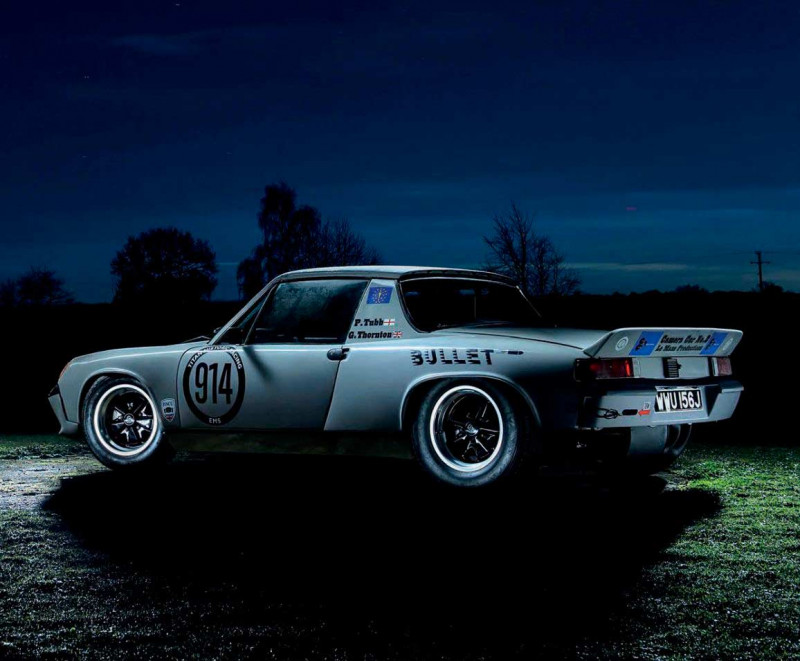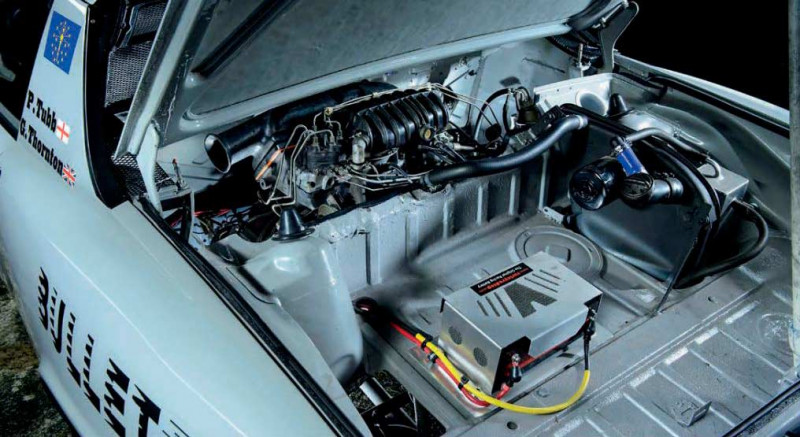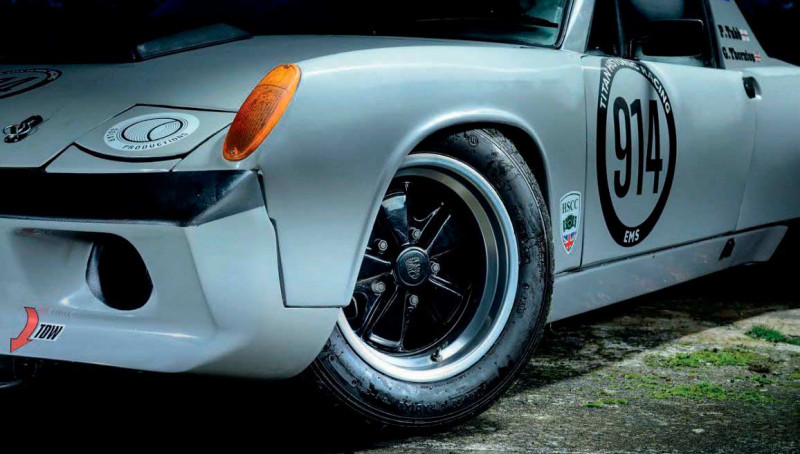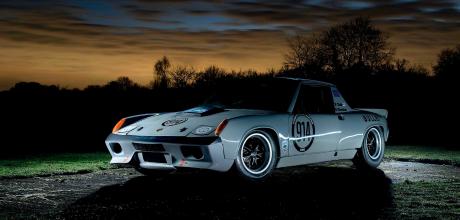Restomods 200bhp 1969 Porsche 914/6
Peeling back the layers of this mysterious 914 has led its owner to believe he may be in possession of a Porsche used in the filming of the greatest movie made about sports car racing… Words Emma Woodcock. Photography Steve Hall.
Restomods a pre-production 1969 Porsche 914 with a story to tell
LIGHTS, CAMERA, ACTION!
Le Mans is a motor racing movie like no other. Filmed over six months in 1970 at behest of Hollywood A-lister and racing fanatic, Steve McQueen, it’s got a scale no other automotive flick can match. The script explores the conflict between risk and reward, confronting McQueen’s Michael Delaney with the widow of another racer, but the cars are the real stars. Solar Productions secured a high number of road and race four-wheelers for filming (many supplied by Porsche works driver, Joe Siffert, and converted with wide-arch bodywork by Franco Sbarro in Yverdon), installed real-life Le Mans heroes, including Derek Bell and Richard Attwood, and, amazingly, hired Circuit de la Sarthe for the duration. Spoiler alert: just like the real 1970 24 Hours of Le Mans, a pair of 917s take the flag for a one-two finish.

Porsches played a major role in filming. In fact, you can read all about Le Mans and its star cars by ordering a back. In the movie, Delaney is shown driving a Slate Grey 911 S (a car that would later find its way into McQueen’s personal collection) en route to the track, while much of the film’s on-board footage was captured by a 908/2 racer. Also owned by the King of Cool, the sports-prototype was converted to carry two onboard cameras in readiness for its participation in the actual 1970 24 Hours of Le Mans. Indicative of the period’s less than reliable action camera technology, however, much of the footage turned out to be unusable, which is why Solar Productions invested in other Porsches to act as camera cars for shooting ‘drop in’ sequences after the conclusion of what was billed as the 38th Grand Prix of Endurance.
Among their investments, McQueen and his associates chose the 914 for the job, utilising the mid-engined model’s combination of space, stability and the option of flat-six power to create versatile camera support vehicles. Away from the lone 914 bought, prepared and paraded in front of the camera (aping the Établissements Sonauto 914/6 GT, which finished sixth overall in the actual race), it’s unknown just many 914s were converted to act as camera cars for the Le Mans crew to work with, but the grey machine in our pictures is believed to be a member of that exclusive club. “The 914s were used to film as close as possible to the action,” says the car’s current owner, Greg Thornton. “We have good reason to believe our car is the second 914 acquired and converted to a Le Mans camera car at the request of Solar Productions.” Regardless of how many Porsches were getting busy behind the camera, each car was worked hard, highlighted by the fact Le Mans used more rolls of film than any previous movie.
MARKET FORCES
After production wrapped, the 914s bought by Solar Productions became surplus to requirements. Sadly, there are no surviving records confirming how the company dispensed of the cars. The 914 on these pages, however, eventually found its way into private ownership in California, racing at the nearby Sonoma Raceway, Laguna Seca and even achieving the lap record for its class at Buttonwillow Raceway Park, before receiving full restoration a decade later. Road-registered and lightly used, the car was still in competition specification when it was recently exported to the United Kingdom and sold by online auction house, The Market. Attracted by the Porsche’s rarity, but not yet able to confirm its possible past, Greg placed the winning bid.

Packing a flat-six, the car was promptly rolled into the workshop of race car preparation specialist, Essex Motorsport Services (EMS), before being rebuilt to enable Greg to compete in historic motorsport competitions. He intends to race the Targa-topped bruiser in the Historic Sports Car Club’s ‘70s Road Sports category and in various tournaments across Europe, which is why the EMS team had to make several alterations to meet local safety regulations — a Cobra Monaco Pro driver’s seat accommodates FIA-mandated Sparco six-point harnesses, while the team has also installed a Lifeline fixed fire suppression system (to replace the handheld extinguisher fitted in North America) and replaced the car’s tired steering wheel with a new flat-bottomed OMP item.
Long before any of these components could be fitted, EMS boss, Perry Tubb, stripped the car down to a bare shell. Structural condition was good, with the roadster showing nothing more than minor welding in known corrosion spots, but the passenger floorpan demanded further investigation. “It had been reinforced, but not in any normal way,” says Greg. “The work was done beautifully, yet it didn’t add structural strength and hadn’t replaced rotten metal.” When superfluous holes and mounting points were uncovered beneath the passenger seat, the pair of Porschephiles began to believe they were correct to assume this unusual 914 could be one of the Le Mans camera cars.
Perhaps they could find answers in the paper trail, using the chassis, engine and transmission numbers to trace the Porsche’s history back to the factory? “It’s one of the first things we do with all our cars,” Greg says, referencing the extraordinary collection of historically significant motorsport machines he presides over as Team Principal of Titan Historic Racing, which Perry serves as Team Manager. Vintage Ferraris, Chevrons, a string of F1 cars from Lotus and March, Titans and even a Surtees TS11 form part of the continually growing Titan Historic Racing fleet. “When we find a car with interesting provenance, we follow up using the network of contacts we’ve got all over the world. The 914, however, threw a curveball our way.” Porsche records confirmed the car’s chassis number was registered in the middle of a sequential set that had no recorded buyers. “There’s always a reason for this kind of anomaly,” Greg continues. “When it comes to Porsches, it means our car was either a demonstration vehicle or, more likely, it had been given to a third party outside the usual retail channels.” His 914’s Certificate of Title supports the theory, recording the boxy roadster as a 1969 pre-production example.
PARTS OF THE PROCESS
Investigation of the engine number further suggested that the team were looking at a special machine. “We discovered this car was never considered a ‘matching numbers’ 914, primarily because the chassis wasn’t paired with an engine at the factory.” It’s believed each of the Solar Productions 914 camera cars were fitted with flat-six engines, although there’s no firm proof of which specification boxer was fitted to this particular 914. Greg suspects it to be a 2.2-litre unit, though today, the car makes use of a potent three-litre powerplant lifted from a donor 911 SC. It’s enough for the car to be nicknamed Bullet, clearly a nod to the McQueen movie, Bullitt, but primarily a reference to how quick this little Porsche is at the track.

In the course of Greg’s investigation, he established six 914s are recorded with the same paperwork anomalies, though no-one can yet confirm which or how many of these cars were used in the filming of Le Mans. “Our starting point is always assumption and educated guesses,” he explains. “We then pick up little bits of information from classic issues of Autosport, Road & Track, period photographs and film footage, manufacturer documentation, retired race team engineers and, suddenly, you see history come together.” As if to prove the point, after months searching through smoke and mirrors, the Titan team uncovered a period photo of Le Mans camera cars with possible visual confirmation of the grey car’s history.
It all comes down to the bodywork. Far wider than a standard 914 or 914/6, but bereft of the boxy extensions fitted to the later 914/6 GT competition cars, Le Mans camera cars appear to wear unique wheel arches that match Greg’s car perfectly. “We thought the arches were fibreglass fairings when we first saw them, but closer examination proved them to be all metal,” he explains. The wider arches stretch over substantially modified running gear that pre-dates the car’s arrival in England.
Key features include fifteen-inch Fuchs alloys with 235-section front and 255-section rear tyres, 911 calipers in each corner and thoroughly revised suspension. Using front torsion bars and rear Koni coilovers, the system evokes the factory 914/6 and accommodates revised geometry, as well as substantially extended front and rear track. Greg elected to preserve the specification of his purchase where possible, meaning further developments are limited. Instead, Perry focused his attention on safety, fitting new braided brakes lines, EBC performance discs and pads from the same manufacturer. He also crack-tested all suspension mounts and supporting components.
Further investigation of the suspension revealed intriguing points of difference distinguishing this car from other 914s. Several components are constructed from lightweight alloy, including the anti-roll bars, suspension uprights and stub axles. “Around half of the components that aren’t aluminium on a normal 914/6 are made of alloy on this car,” says Greg. “We couldn’t find any aftermarket suppliers who make similar parts. The quality of workmanship is absolutely fantastic.”
ENGINE ROOM
More extensive work was required to get the engine running smoothly, with Perry concentrating his efforts on the K-Jetronic mechanical fuel injection that came fitted to the car — the EMS team has rebuilt the system three times and tested the 914 on the Revivals rolling road (located near Imperial War Museum Duxford) on no fewer than ten occasions. “The guy who runs the dyno at Revivals is a bit of a boffin,” Greg laughs. “The flat-six powering this car is producing a safe 195bhp, but he’s adamant there’s much more to come,” he adds, recognising a 911 SC rewards its driver with 201bhp. Otherwise in good condition, the flat-six has benefited from a borescope inspection, an oil cooler overhaul and the addition of remanufactured exhaust sections.
Greg and Perry struck the same balance between renovation and posterity when it came to revitalising the bodyshell, limiting paintwork to a respray of the cabin and select areas of the exterior, whilst retaining the majority of the pre-existing grey paintwork. Inside, you can still search out the telltale floor modifications, but they’re now joined by reinforced mounts near the driver’s seat, which help support a substantial new roll cage.
He might have uncovered potential links to a unique history, but Greg is keen to remind us he bought the 914 to compete with. “Solar Productions camera cars had to be prepared and certified to race at Le Mans in order for them to take to the track and get the required footage,” he explains. “Much of the captured film was shot after the race, but the bottom line is that Le Mans camera cars were prepared in the same way you’d ready a race car for action. It’s this spirit that will continue as Perry and I prepare to hit the track in this special Porsche either side of trying to uncover the car’s true identity.” It’s just like Michael Delaney says. Racing is life. Anything before or after is just waiting.
Above There’s filling an arch gap, and then there’s this! Above Paperwork highlights the car as a pre-production 914, though Perry and his brother, Lee, have prepared the car with modern electrics and plumbing suited to today’s historic motorsport.
HE ESTABLISHED SIX 914s ARE RECORDED WITH THE SAME PAPERWORK ANOMALIES
Above Perry and Greg intend to campaign the 914 alongside a fleet of amazing vintage race cars held on the Titan Historic Racing fleet.
FERRARIS, CHEVRONS, A STRING OF F1 CARS FROM LOTUS AND MARCH, TITANS AND EVEN A SURTEES


